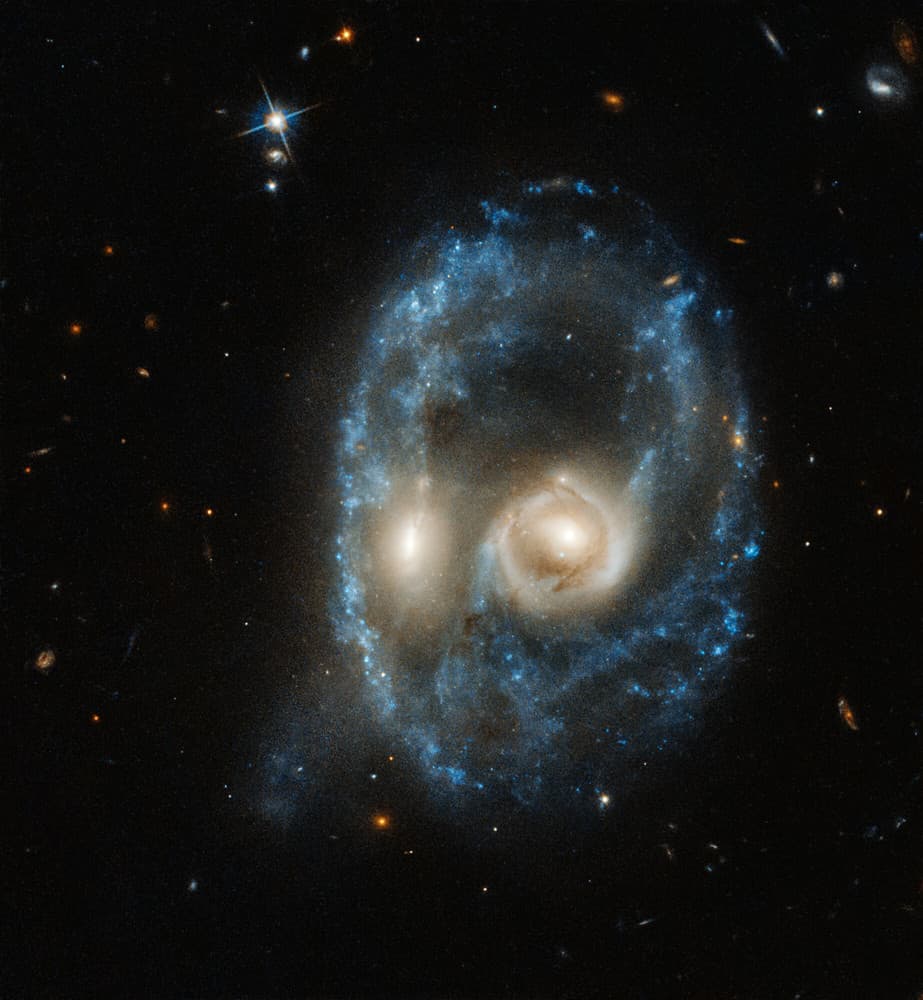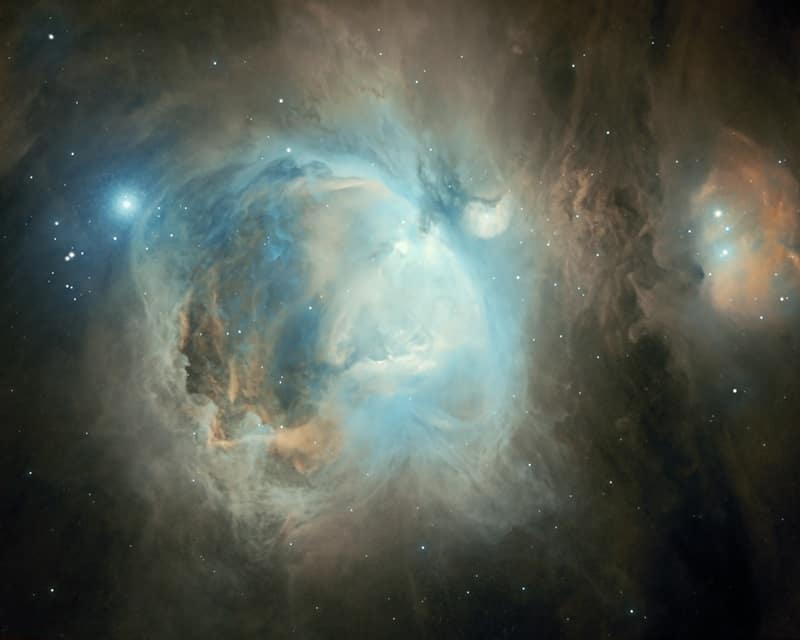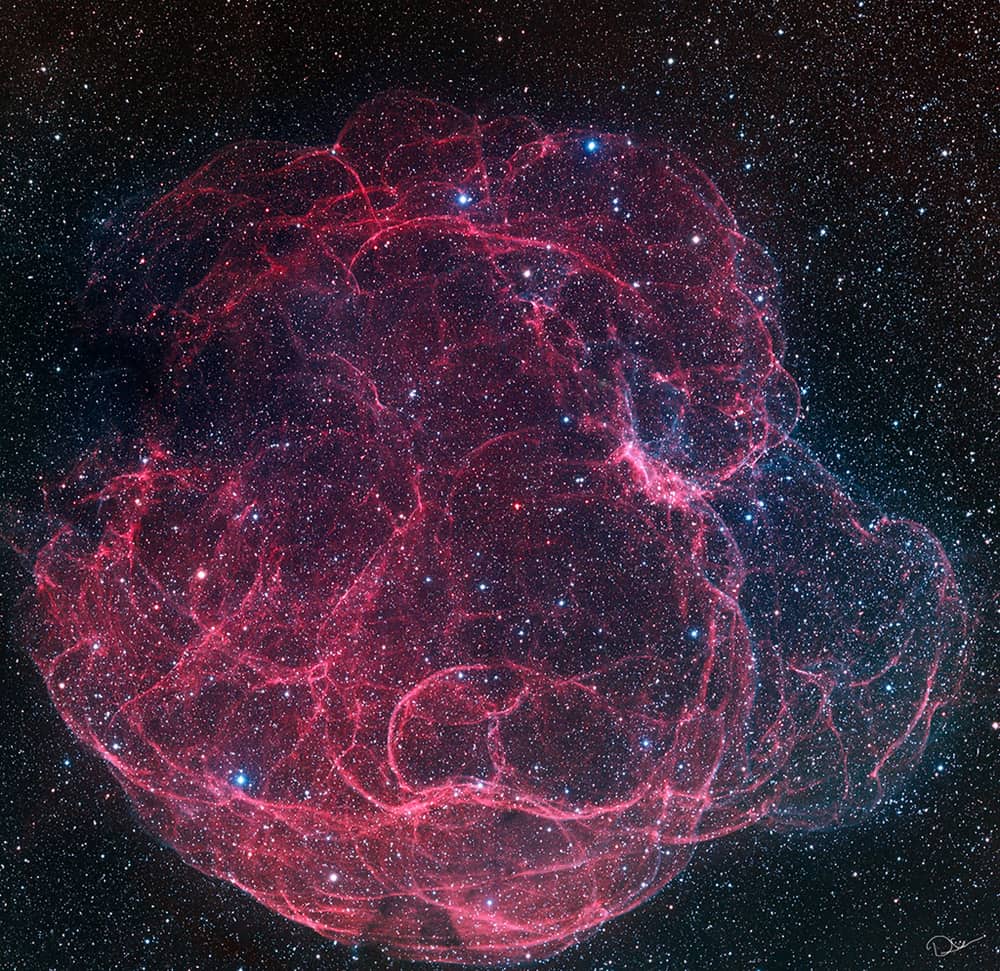Blog
This new image from the NASA/ESA Hubble Space Telescope captures two galaxies of equal size in a collision that appears to resemble a ghostly face. This observation was made on 19 June 2019 in visible light by the telescope’s Advanced Camera for Surveys. Residing 704 million light-years from Earth, this system is catalogued as Arp-Madore 2026-424 (AM 2026-424) in the Arp-Madore “Catalogue of Southern Peculiar Galaxies and Associations”.
Hubble is looking at a titanic head-on collision between two galaxies. Each “eye” is the bright core of a galaxy, one of which slammed into another. The outline of the face is a ring of young blue stars. Other clumps of new stars form a nose and mouth. The entire system is catalogued as Arp-Madore 2026-424 (AM 2026-424), from the Arp-Madore “Catalogue of Southern Peculiar Galaxies and Associations.”
Although galaxy collisions are common — especially back in the young universe — most of them are not head-on smashups, like the collision that likely created this Arp-Madore system. The violent encounter gives the system an arresting “ring” structure for only a short amount of time, about 100 million years. The crash pulled and stretched the galaxies’ disks of gas, dust and stars outward. This action formed the ring of intense star formation that shapes the nose and face. Ring galaxies are rare; only a few hundred of them reside in our larger cosmic neighborhood. The galaxies have to collide at just the right orientation to create the ring. The galaxies will merge completely in about 1 to 2 billion years, hiding their messy past. The side-by-side juxtaposition of the two central bulges of stars from both galaxies also is unusual. Because the bulges that make the eyes appear to be the same size, it is evidence that two galaxies of nearly equal proportions were involved in the crash, rather than more common collisions where small galaxies are gobbled up by their larger neighbors. Hubble observed this unique system as part of a “snapshot” program that takes advantage of occasional gaps in the telescope’s observing schedule to squeeze in additional pictures. Astronomers plan to use this innovative Hubble program to take a close look at many other unusual interacting galaxies. The goal is to compile a robust sample of nearby interacting galaxies, which could offer insight into how galaxies grew over time through galactic mergers. By analyzing these detailed Hubble observations, astronomers could then choose which systems are prime targets for follow-up with NASA’s James Webb Space Telescope, scheduled to launch in 2021. Astronomer Halton Arp published his compendium of 338 unusual-looking interacting galaxies in 1966. He later partnered with astronomer Barry Madore to extend the search for unique galactic encounters in the southern sky. Several thousand galaxies are listed in that survey, published in 1987. The Hubble image of AM 2026-424 was taken June 19, 2019, in visible light by the Advanced Camera for Surveys. The system resides 704 million light-years from Earth.

Ray Drummond (born November 23, 1946 in Brookline, Massachusetts) is a jazz bassist and teacher. He also has an MBA from Stanford University, hence his linkage to the Stanford Jazz Workshop. He can be heard on hundreds of albums and co-leads The Drummonds with Renee Rosnes and (not related) Billy Drummond.
Drummond has been a resident of Teaneck, New Jersey, since 1980 with his wife, Susan, and his daughter, Maya.
He is the elder brother of David Drummond, senior vice president, corporate development and chief legal officer of Google Inc.
more...R. L. Burnside (November 23, 1926 – September 1, 2005) was an American blues singer, songwriter, and guitarist. He played music for much of his life but received little recognition before the early 1990s. In the latter half of that decade, Burnside recorded and toured with Jon Spencer, garnering crossover appeal and introducing his music to a new fan base in the punk and garage rock scenes.
Burnside was born in 1926 to Earnest Burnside and Josie Malone, in either Harmontown, College Hill, or Blackwater Creek, all of which are in the rural part of Lafayette County, Mississippi, near the area that would be covered by Sardis Lake a few years later. His first name is given variously as R. L., Rural, Robert Lee, Rule, or Ruel. His father left the family early on, and R. L. grew up with his mother, grandparents, and several siblings.
https://www.youtube.com/watch?v=VeYI_0yDyxE
more...https://www.youtube.com/watch?v=z_G8eaYTJF0
more...This bi-color image of the Orion Nebula (M42) was taken through Hydrogen-alpha and Oxygen-III filters. This celestial object combines emission, reflection, and dark nebulosity into one star-forming region. The Orion Nebula (also known as Messier 42, M42, or NGC 1976) is a diffuse nebula situated in the Milky Way, being south of Orion’s Belt in the constellation of Orion. It is one of the brightest nebulae, and is visible to the naked eye in the night sky. M42 is located at a distance of 1,344 ± 20 light yearsand is the closest region of massive star formation to Earth. The M42 nebula is estimated to be 24 light years across. It has a mass of about 2,000 times that of the Sun. Older texts frequently refer to the Orion Nebula as the Great Nebula in Orion or the Great Orion Nebula.

Jesse Colin Young is an American singer and songwriter. He was a founding member and lead singer of the 1960s group The Youngbloods. Young was born Perry Miller on November 22, 1941 and raised in Queens, New York. His mother was a violinist, and his father was an accountant with a strong interest in classical music. When he was 15 years old, Young received a scholarship to Phillips Academy in Andover, Massachusetts. He was later expelled from the school.
During the 1960s, while living in the Greenwich Village section of Manhattan, Young released two solo albums, The Soul of a City Boy and Young Blood. He then formed the group the Youngbloods with guitarist Jerry Corbitt, keyboardist and guitarist Lowell “Banana” Levinger, and drummer Joe Bauer. The group’s first album contained the song “Get Together“, written by Chet Powers, which was re-released as a single in 1969. Young and his band founded Raccoon Records and released four additional albums on that label.
https://www.youtube.com/watch?v=kLVWxuMsiDQ
more...James Minter Knepper (November 22, 1927 – June 14, 2003) was an American jazz trombonist. In addition to his own recordings as leader, Knepper performed and recorded with Charlie Barnet, Woody Herman, Claude Thornhill, Stan Kenton, Benny Goodman, Gil Evans, Thad Jones and Mel Lewis, Toshiko Akiyoshi and Lew Tabackin, and, most famously, Charles Mingus in the late 1950s and early 1960s. Knepper died in 2003 of complications of Parkinson’s disease.
Knepper was born in Los Angeles, California, the second son of a nurse and a police officer. His parents divorced shortly after his birth, and his mother had to take her abusive husband to court in order to get child support. He and his older brother, Robert, were sent to several boarding and military schools, Page Military Academy and St. John’s Military Academy, while their mother worked. He picked up his first instrument, an alto horn, at the age of 6 while he was a pupil there. His first teacher persuaded him to put aside the alto and pick up the trombone because, as he said, he had a “trombone mouth”. He played his first professional gigs in LA, and traveled to Spokane, WA at the age of 15. He graduated high school, and later attended classes at Los Angeles Community College.
more...Hoagland Howard “Hoagy” Carmichael (November 22, 1899 – December 27, 1981) was an American singer, songwriter, and actor. American composer and author Alec Wilder described Carmichael as the “most talented, inventive, sophisticated and jazz-oriented of all the great craftsmen” of pop songs in the first half of the 20th century. Carmichael was one of the most successful Tin Pan Alley songwriters of the 1930s and was among the first singer-songwriters in the age of mass media to utilize new communication technologies, such as television and the use of electronic microphones and sound recordings.
Carmichael composed several hundred songs, including 50 that achieved hit record status. He is best known for composing the music for “Stardust“, “Georgia on My Mind” (lyrics by Stuart Gorrell), “The Nearness of You“, and “Heart and Soul” (in collaboration with lyricist Frank Loesser), four of the most-recorded American songs of all time. He also collaborated with lyricist Johnny Mercer on “Lazybones” and “Skylark.” Carmichael’s “Ole Buttermilk Sky” was an Academy Award nominee in 1946, from Canyon Passage, in which he co-starred as a musician riding a mule. “In the Cool, Cool, Cool of the Evening,” with lyrics by Mercer, won the Academy Award for Best Original Song in 1951. Carmichael also appeared as a character actor and musical performer in 14 films, hosted three musical-variety radio programs, performed on television, and wrote two autobiographies.
Born in Bloomington, Indiana, on November 22, 1899, Hoagland Howard “Hoagy” Carmichael was the first child and only son of Howard Clyde and Lida Mary (Robison) Carmichael. His parents named him after a circus troupe called the “Hoaglands” that had stayed at the Carmichael house during his mother’s pregnancy.
more...Featuring Fandangos.
The earliest fandango melody is found in the anonymous “Libro de diferentes cifras de guitarra” from 1705, and the earliest description of the dance itself is found in a 1712 letter by Martín Martí, a Spanish priest. The fandango’s first sighting in a theatrical work was in Francisco de Leefadeal‘s entremés “El novio de la aldeana” staged in Seville, ca. 1720. By the late 18th century it had become fashionable among the aristocracy and was often included in tonadillas, zarzuelas, ballets and operas, not only in Spain, but also elsewhere in Europe.
Widely varying claims have been made about the origin of fandango: its relation to the soleá, jabera and petenera; to the Andalusian malagueña, granadina, murciana and rondeña; to the canarioand gitano; to the jota aragonesa
more...Tribute to Bill Thompson.
Passed on June 14, 2015.
I published his album Cat Went Blind (interesting story) on YouTube.
I played drum kit on the album and helped with Production and Editing. Recorded in River Falls, WI and mastered by Christopher Blood.
This is my favorite tune Black Grate with the exquisitely haunting fiddle/violin of Lisa Fuglie; with Mike Rivard on bass.
Intricate looping filaments in this detailed image of supernova remnant Simeis 147. Also cataloged as Sharpless 2-240 it goes by the popular nickname, the Spaghetti Nebula.Seen toward the boundary of the constellations Taurus and Auriga, it covers nearly 3 degrees or 6 full moons on the sky. That’s about 150 light-years at the stellar debris cloud’s estimated distance of 3,000 light-years. This composite includes image data taken through narrow-band filters where reddish emission from ionized hydrogen atoms and doubly ionized oxygen atoms in faint blue-green hues trace the shocked, glowing gas. The supernova remnant has an estimated age of about 40,000 years, meaning light from the massive stellar explosion first reached Earth 40,000 years ago. But the expanding remnant is not the only aftermath. The cosmic catastrophe also left behind a spinning neutron star or pulsar, all that remains of the original star’s core.

Alphonse Lee Mouzon (November 21, 1948 – December 25, 2016) was an American jazz fusion drummer and the owner of Tenacious Records, a label that primarily released Mouzon’s recordings. He was a composer, arranger, producer, and actor. He gained popularity in the late 1960s and early 1970s.
Mouzon, of African, French, and Blackfoot descent, was born on November 21, 1948, in Charleston, South Carolina. He received his first musical training at Bonds-Wilson High School, and moved to New York City upon graduation. He studied drama and music at the City College of New York, as well as medicine at Manhattan Medical School. He continued receiving drum lessons from Bobby Thomas, the drummer for jazz pianist Billy Taylor. He played percussion in the 1968 Broadway show Promises, Promises, and he then worked with pianist McCoy Tyner. He spent a year as a member of the jazz fusion band, Weather Report. After that Mouzon signed as a solo artist to the Blue Note label in 1972.
Mouzon’s visibility increased during his tenure with guitarist Larry Coryell‘s Eleventh House fusion band from 1973 to 1975. Albums from this period include Introducing the Eleventh House, Level One, Mind Transplant (a solo album), and in 1977, a reconciliation recording with Coryell entitled Back Together Again.
Mouzon recorded Mind Transplant in 1974 with guitarist Tommy Bolin, who had previously played on Billy Cobham‘s Spectrum.
He recorded four R&B albums: The Essence of Mystery (Blue Note, 1972), Funky Snakefoot (Blue Note, 1973), The Man Incognito (Blue Note, 1976) (including “Take Your Troubles Away”), and in the 1980s By All Means, which featured Herbie Hancock, Lee Ritenour, the Seawind Horns, and Freddie Hubbard.
https://www.youtube.com/watch?v=8ybIzZNesXU
more...Carlos Manuel “Charlie” Palmieri (November 21, 1927 – September 12, 1988) was a renowned bandleader and musical director of salsa music. He was known as the “Giant of the Keyboards”. Palmieri’s parents migrated to New York from Ponce, Puerto Rico in 1926 and settled down in the South Bronx where Palmieri was born. As a child, Palmieri taught himself to play the piano by ear. He attended the public school system. At age 7, his father enrolled him at The Juilliard School, where he took piano lessons. By the time Palmieri was 14 years old, he and his 5-year-old brother, Eddie, participated in many talent contests, often winning prizes. It was at this time that his godfather introduced him to the music of the Latin bands – an experience which inspired him to become a musician. In 1943, when still only 16 years old and still in high school, he made his professional debut as a piano player for the Osario Selasie Band. He graduated from high school in 1946, and immediately went to play for various bands. He made his recording debut with the song “Se Va La Rumba” as a member of the Rafael Muñiz Band. In October 1947, Tito Puente, the musical director of the Fernando Álvarez Band, was impressed with Palmieri and hired him to play for his band at the Copacabana Club; here he played with Tito until 1953 and during the 1950s he played with various bands. Besides having played with Tito Puente, he played with Pupi Campo’s Band and worked on Jack Paar‘s CBS daytime television show. Palmieri also formed a couple of bands that performed at the Palladium Ballroom – these were however short-lived because of a lack of work. During this time, he also worked as an accompanist for other bands.
Sal Salvador (1925–1999) was a bebop jazz guitarist and a prominent music educator.
Salvador was born in Monson, Massachusetts and began his professional career in New York City. He eventually moved to Stamford, Connecticut. He taught guitar at the University of Bridgeport in Bridgeport, Connecticut as well as at Western Connecticut State University in Danbury, Connecticut. He authored several instruction books for beginning to advanced guitarists.
In addition to recordings with Stan Kenton and with his own groups, Salvador can be heard in the film Blackboard Jungle during a scene in a bar where a recording on which he is featured is played on the jukebox. He is also featured playing with Sonny Stitt in the film Jazz on a Summer’s Day at the Newport Jazz Festival.
https://www.youtube.com/watch?v=S3EG-mOcy94
more...Coleman Randolph Hawkins (November 21, 1904 – May 19, 1969), nicknamed “Hawk” and sometimes “Bean”, was an American jazz tenor saxophonist. One of the first prominent jazz musicians on his instrument, as Joachim E. Berendt explained: “there were some tenor players before him, but the instrument was not an acknowledged jazz horn”. Hawkins biographer John Chilton described the prevalent styles of tenor saxophone solos prior to Hawkins as “mooing” and “rubbery belches.” Hawkins cited as influences Happy Caldwell, Stump Evans, and Prince Robinson, although he was the first to tailor his method of improvisation to the saxophone rather than imitate the techniques of the clarinet. Hawkins’ virtuosic, arpeggiated approach to improvisation, with his characteristic rich, emotional, loud, and vibrato-laden tonal style, was the main influence on a generation of tenor players that included Chu Berry, Charlie Barnet, Tex Beneke, Ben Webster, Vido Musso, Herschel Evans, Buddy Tate, and Don Byas, and through them the later tenormen, Arnett Cobb, Illinois Jacquet, Flip Phillips, Ike Quebec, Al Sears, Paul Gonsalves, and Lucky Thompson. While Hawkins became well known with swing music during the big band era, he had a role in the development of bebop in the 1940s.
Fellow saxophonist Lester Young, known as “Pres”, commented in a 1959 interview with The Jazz Review: “As far as I’m concerned, I think Coleman Hawkins was the President first, right? As far as myself, I think I’m the second one.” Miles Davis once said: “When I heard Hawk, I learned to play ballads.” Hawkins was born in Saint Joseph, Missouri, in 1904. Although some sources say 1901, there is no evidence to prove an earlier date; instead, there is record of Hawkins’s parents’ first child, a girl, being born in 1901 and dying at the age of two, possibly the basis for the mistaken belief. He was named Coleman after his mother Cordelia’s maiden name.
More Posts
- The Cosmos with M57
- Philly Joe Jones Day
- Sadik Hakim Day
- World Music with Abdelslam Alikane Souiri et Songhoy Blues
- Daily Roots with Lee Perry
- DRUM JAM 7-14-18
- The Cosmos with SDSS J0333+0651
- Angelique Kidjo Day
- Henry “Rubberlegs” Williams Day
- World Music with Noe hernandez cantarell
- Daily Roots with Barry Brown
- The Cosmos with NGC 3627
- Albert Ayler Day
- Pete Escovedo Day
- World Music with Paco de Lucia
- Daily Roots with Michael Rose
- The Cosmos with RCW38
- Big John Patton Day
- Paul Gonsalves Day
- World Music with Martá Sebestyén